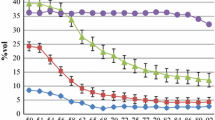Summary
A possible method of manipulating allelopathy would be to develop crop varieties showing an increased tolerance to allelopathic chemicals. We therefore examined four flax (Linum usitatissimum) varieties and two wild Linum species in the presence of p-coumaric acid and four barley (Hordeum vulgare) varieties in the presence of p-coumaric acid, scopoletin and wild oat (Avena fatua) extract. Analysis of variance indicates significant interaction between variety and treatment for shoot and root growth for seedling flax, shoot growth for older flax, and root growth for seedling barley. These differences in tolerance between varieties could be exploited to develop-varieties with greater tolerances to the allelochemicals produced by weeds or in crop residues and therefore potentially more tolerant of the presence of weeds.
Similar content being viewed by others
References
Alsaadawi IS, Al-Uqaili JK, Alrubeaa AJ, Al-Hadithy SM (1986) Allelopathic suppression of weed and nitrification by selected cultivars of Sorghum bicolor (L.) Moench. J Chem Ecol 12:209–219
Barnes JP, Putnam JR, Burke BA (1986) Allelopathic activity of rye (Secale cereale L.). In: Putnam AR, Tang C-S (eds) The science of allelopathy. John Wiley, New York, pp 271–286
Baum BR (1968) On some relationship between Avena sativa and A. fatua (Gramineae) as studied from Canadian material. Can J Bot 46:1013–1024
Einhellig FA, Leather GR (1988) Potential for exploiting allelopathy to enhance crop production. J Chem Ecol 14:1829–1844
Einhellig FA, Rasmussen JA (1978) Synergistic inhibitory effects of vanillic and p-hydroxybenzoic acids on radish and grain sorghum. J Chem Ecol 4:425–436
Fay PK, Duke WB (1977) An assessment of allelopathic potential in Avena germ plasm. Weed Sci 25:224–228
Guenzi WD, McCalla TM (1966) Phenolic acids in oats, wheat, sorghum, and corn residues and their phytotoxicity. Agron J 58:303–304
Huber DM, Abney TS (1986) Soybean allelopathy and subsequent cropping. J Agron Crop Sci 157:73–78
Lockerman RH, Putnam AR (1979) Evaluation of allelopathic cucumbers (Cucumis sativus) as an aid to weed control. Weed Sci 27:54–57
Lockerman RH, Putnam AR (1981) Mechanisms for differential interference among cucumber (Cucumis sativus L.) accessions. Bot Gaz 142:427–430
Massantini F, Caporali F, Zellini G (1977) Evidence for allelopathic control of weeds in lines of soybean. Symp different methods weed control integration 1:23–28
O'Donovan JT, Sharma MP (1983) Wild oats, competition and crop losses. In: Smith, AE (ed) Proc Wild Oat Action Committee Symp. Regina, Sask., pp 27–42
Peters EJ, Zam AHBM (1981) Allelopathic effects of tall fescue genotypes. Agron J 73:56–58
Putnam AR, Duke WB (1974) Biological suppression of weeds: evidence for allelopathy in accessions of cucumber. Science 185:371–372
Putnam AR, Tang C-S (1986) Allelopathy: state of the science. In: Putnam AR, Tang C-S (eds) The science of allelopathy. John Wiley, New York, pp 1–19
Putnam AR, Weston LA (1986) Adverse impacts of allelopathy in agricultural systems. In: Putnam AR, Tang C-S (eds) The science of allelopathy. John Wiley, New York, pp 43–56
Qasem JR, Hill TA (1989) On difficulties with allelopathy methodology. Weed Res 29:345–347
Rasmussen JA, Einhellig FA (1977) Synergistic inhibitory effects of p-coumaric acid and ferulic acids on germination and growth of grain sorghum. J Chem Ecol 3:197–205
Reeves TG, Brooke HD (1977) The effect of genotype and phenotype on the competition between wheat and annual ryegrass (Lolium rigidum Gaud.). In: Proc. 6th Asian Pacific Weed Sci Conf. Jakarta, pp 166–172
Schumacher WJ, Thill DC, Lee GA (1983) Allelopathic potential of wild oat (Avena fatua) on spring wheat (Triticum aestivum) growth. J Chem Ecol 9:1235–1245
Tinnin RO, Muller CH (1972) The allelopathic influence of Avena fatua: the allelopathic mechanism. Bull Torrey Bot Club 99:287–292
Wetter LR, Constabel F (1982) Plant tissue culture methods, 2nd edn. Nat Res Council of Canada, Saskatoon
Author information
Authors and Affiliations
Additional information
Communicated by A. R. Hallauer
Rights and permissions
About this article
Cite this article
Ray, H., Hastings, P.J. Variation within flax (Linum usitatissimum) and barley (Hordeum vulgare) in response to allelopathic chemicals. Theoret. Appl. Genetics 84, 460–465 (1992). https://doi.org/10.1007/BF00229507
Received:
Accepted:
Issue Date:
DOI: https://doi.org/10.1007/BF00229507




